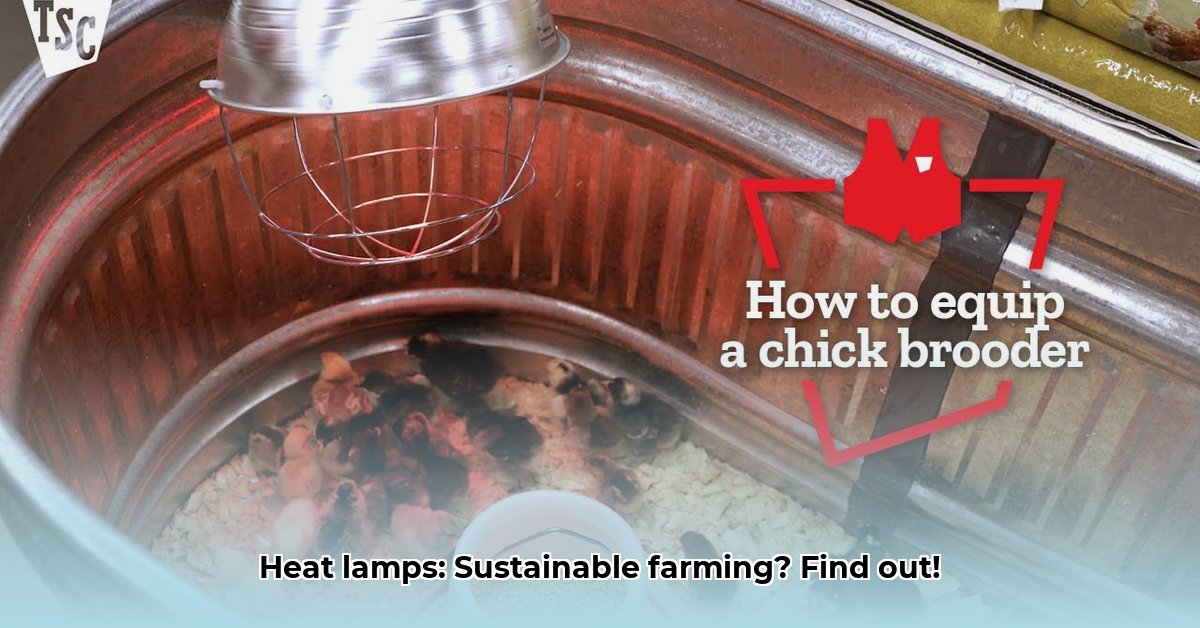
Winter's harsh chill can significantly impact livestock health and crop yields. Heat lamps offer a crucial solution, but selecting and using them responsibly is vital for both farm profitability and environmental sustainability. This guide explores Tractor Supply's heat lamp offerings, providing actionable steps for efficient, safe, and eco-conscious usage. For more on raised beds, check out this helpful resource: Tractor Supply Raised Beds.
Choosing the Right Heat Lamp
Selecting the appropriate heat lamp hinges on matching its power (wattage) to your specific needs. A small brooder requires significantly less wattage than a large barn housing livestock. Tractor Supply offers a variety of wattages; higher wattage provides more intense heat but consumes more electricity. Precise wattage selection is key to achieving optimal warmth while minimizing energy waste.
The size of the area needing heating directly influences wattage requirements. A low-wattage bulb (e.g., 75 watts) suffices for a small brooder or a few seedlings. Larger areas or larger animals might necessitate higher wattages (150-250 watts) or multiple strategically placed lamps.
Consider the following:
| Wattage | Approximate Coverage Area (sq ft) | Best Suited For |
|---|---|---|
| 75W | 10-20 | Small brooder, individual animal, small plant group |
| 150W | 20-40 | Medium brooder, several small animals, multiple plants |
| 250W | 40-60 | Large brooder, larger animals, frost protection of larger areas |
Note: These are estimates. Actual coverage depends on insulation, ambient temperature, and reflector design. Always consult the manufacturer’s specifications.
Safely and Efficiently Using Your Heat Lamps
Prioritizing safety is paramount when using heat lamps. Improper use can lead to fires, burns, and other hazards. Follow these crucial steps:
Secure Mounting: Never improvise lamp placement. Use a sturdy clamp or hanging fixture specifically designed for heat lamps. These are readily available at Tractor Supply. A wobbly lamp is a significant fire risk.
Maintain Safe Distance: Keep flammable materials (bedding, hay) far from the lamp. The safe distance varies depending on wattage and the material being heated. Always consult the manufacturer’s recommendations. For livestock, ensure sufficient distance to prevent burns, yet close enough to provide warmth. Plant proximity depends on their heat sensitivity; experiment cautiously to find the ideal distance.
Prevent Fires: Never leave a heat lamp unattended, especially overnight. Ensure adequate ventilation to prevent overheating. Regularly inspect the cord and fixture for wear; replace damaged parts immediately. Proactive inspection prevents accidents.
Regular Maintenance: Regularly check for damage or overheating. A quick visual inspection can preempt many problems. This simple step significantly reduces safety risks.
The Environmental Impact: Sustainability and Heat Lamps
While heat lamps are essential, their energy consumption has an environmental impact. Electricity generation often relies on fossil fuels. Reducing this impact is crucial for sustainable farming.
How can we lessen the environmental footprint?
Energy-Efficient Models: Opt for lamps with higher infrared (IR) output and improved reflectors to direct heat more effectively (IR lamps are inherently more efficient than incandescent lamps). These might have a higher initial cost but lower energy consumption over time.
Smart Timing: Use timers to avoid unnecessary energy expenditure. Don't waste energy heating an empty brooder overnight. Strategic use minimizes environmental impact.
Renewable Energy Sources: Consider powering lamps with renewable energy (solar panels). This is a substantial long-term investment but offers a sustainable solution.
Cost-Benefit Analysis: Balancing Costs and Benefits
Heat lamps are relatively inexpensive, but energy costs are the major factor in a cost-benefit analysis. Calculate the cost per hour of lamp use: consider wattage, electricity rate, and daily use. This aids in comparing different heating solutions and optimizing energy efficiency. Energy-efficient models may have higher upfront costs, but long-term savings in energy consumption often offset this.
Responsible Disposal: End-of-Life Management
Proper disposal of end-of-life heat lamps is crucial. Many components are recyclable. Consult your local waste management facility for recycling guidelines on e-waste. Responsible disposal minimizes environmental impact.
The Future of Sustainable Heating in Agriculture
Ongoing research explores more sustainable agricultural heating. Innovations in energy-efficient technologies and renewable energy applications offer promising solutions. Staying informed about these developments is vital for adopting even more sustainable practices in the future.
Key Takeaways: Reducing Energy Consumption
- Lamp Selection: Choose energy-efficient infrared models matched to your specific needs.
- Efficient Installation and Use: Optimize positioning, use timers, and avoid excess energy use.
- Cost Analysis: Perform regular cost-benefit calculations to optimize spending and energy efficiency.
- Sustainable Disposal: Follow proper e-waste recycling guidelines.
- Ongoing Learning: Stay updated on sustainable heating technology advancements.
By implementing these guidelines, farmers can significantly reduce their environmental impact while maintaining efficient and cost-effective livestock and crop management.